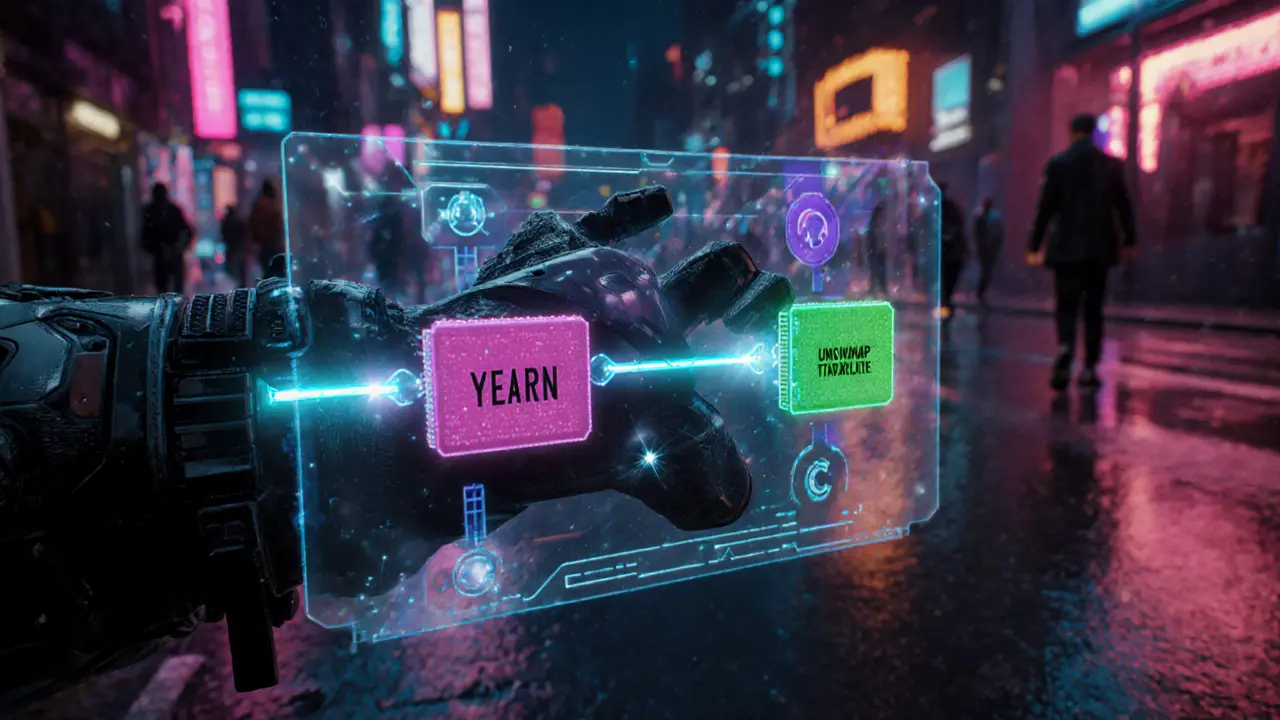DeFi Money Legos Builder
Select Your Legos
Your Strategy
Select Legos to build your DeFi strategy.
Imagine you could snap together finance tools the way you build with LEGO bricks. DeFi Money Legos let you do just that-combine simple, open‑source financial pieces into brand‑new services without re‑inventing the wheel.
Quick Takeaways
- Money Legos are reusable smart‑contract modules that can be linked together on a blockchain.
- Composability lets developers layer payments, lending, trading, and more in a single workflow.
- Ethereum hosts the majority of Legos, but Solana, Polygon, and others are catching up.
- Platforms like Furucombo let anyone experiment with Lego combos without coding.
- Building with Legos shortens development time, reduces bugs, and fuels rapid innovation.
What Are DeFi Money Legos?
DeFi Money Legos are composable, programmable building blocks that live on a blockchain and perform financial functions such as lending, swapping, or providing liquidity. Each block is a smart contract that anyone can call, and because the contracts share the same underlying blockchain, they can interact directly-no middle‑man required.
Think of a Lego brick that represents an AMM (automated market maker). You can attach that brick to a borrowing brick, a staking brick, or a flash‑loan brick, creating a new structure that does something none of the pieces could do alone.
How Composability Works Under the Hood
All Legos run on top of a blockchain’s execution environment. When a developer writes a new contract, they simply import the address of an existing Lego and call its functions. The blockchain ensures atomicity-either the whole sequence succeeds or everything reverts-so complex strategies stay safe.
Two development approaches dominate:
- Start from scratch: pick a dozen Legos (payments, oracle, collateral) and stitch them together into a brand‑new protocol.
- Layer on top of an existing protocol: add a new feature on top of, say, Aave’s lending Lego, turning it into a yield‑optimizing wrapper.
This flexibility is why the ecosystem has exploded since 2018, when Compound introduced the first widely‑used lending Lego.
Core Categories of Money Legos
Developers typically group Legos into functional families:
- Payments: simple token transfers, cross‑chain bridges.
- Infrastructure: price oracles, randomness beacons.
- Custodial services: token vaults, multi‑sig wallets.
- Exchanges & Liquidity: AMMs like Uniswap, stable‑swap pools like Curve.
- Investing: yield farms, index funds, tokenized ETFs.
- KYC & Identity: decentralized ID solutions.
- Markets & Prediction: betting platforms, options.
- Stablecoins: DAI, USDC, USDH.
- Insurance & Credit: cover against smart‑contract failures, over‑collateralized loans.

Leading Protocols That Act as Money Legos
| Protocol | Primary Function | Approx. TVL (USD) | Key Lego Feature |
|---|---|---|---|
| MakerDAO decentralized stablecoin platform | Generate DAI by locking collateral | $12B | Collateral‑locked stablecoin brick |
| Aave lending and borrowing market | Over‑collateralized loans & flash loans | $9B | Flexible borrowing/lending brick |
| Curve stable‑coin focused AMM | Low‑slippage swaps for similar assets | $15B | Stable‑swap liquidity brick |
| Uniswap general‑purpose AMM | Permissionless token swaps | $8B | Universal swapping brick |
| Yearn yield‑optimizing aggregator | Auto‑routing deposits to highest‑yield strategies | $6B | Yield‑stacking brick |
| Compound algorithmic money market | Earn interest by supplying assets | $5B | Interest‑bearing deposit brick |
| Sushi AMM with on‑chain governance | Swap, stake, and farm tokens | $3B | Governance‑friendly liquidity brick |
| Polygon layer‑2 scaling solution | Fast, low‑cost transactions for Lego combos | $10B (across L2) | Scalable execution environment |
Step‑by‑Step Example: A Multi‑Lego Yield Play
Let’s walk through a concrete strategy that a power user could execute in a single transaction.
- Deposit 10ETH as collateral on Aave, borrowing 5ETH worth of DAI.
- Take the borrowed DAI and supply it to Yearn’s yDAI vault, which auto‑optimizes between Curve, Compound, and other farms.
- With the remaining 5DAI, swap half on Uniswap to acquire a leveraged position on a volatile token.
- Simultaneously stake the other half of the DAI on Curve for low‑slippage stablecoin yields.
- When the market moves in your favor, unwind both positions in the same transaction, repay the Aave loan, and pocket the net profit.
All five steps happen atomically thanks to composability. If any sub‑step fails, the whole chain reverts, protecting the user from partial loss.
Why Developers Love Money Legos
Building a DeFi product from the ground up means writing secure token contracts, implementing price oracles, handling liquidity pools, and more-months of work. By re‑using vetted Legos, a developer can focus on the unique value proposition instead of low‑level plumbing.
- Time savings: Launch in weeks rather than months.
- Security boost: Each Lego has been audited and battle‑tested.
- Modularity: Replace one Lego with a newer version without overhauling the whole stack.
- Community support: Open‑source contributors continuously improve the bricks.
Platforms like Furucombo visual interface for chaining DeFi Legos without code let non‑developers experiment, accelerating idea validation.
Cross‑Chain Legos and the Road Ahead
Until recently most Legos lived on Ethereum, but scaling solutions and other chains are catching up. Solana’s Hubble Protocol stablecoin platform on Solana shows the same composable pattern on a high‑throughput network. Bridge protocols such as Wormhole or LayerZero enable a Lego on one chain to call a Lego on another, opening truly multi‑chain strategies.
Future trends include:
- Standardized Lego APIs: A common interface could let any chain expose its bricks to the broader ecosystem.
- AI‑assisted composition: Tools that suggest optimal Lego combos based on user goals.
- Regulatory‑aware Legos: Modules that embed KYC/AML checks when needed, keeping compliance modular.
As more developers adopt this mindset, we’ll see financial products that are faster to build, safer to use, and richer in functionality.
Quick Checklist for Building with Money Legos
- Identify the core user flow you want to enable.
- Map each step to an existing Lego (e.g., swap = Uniswap, borrow = Aave).
- Verify that all Legos share the same blockchain or have a reliable bridge.
- Run a test transaction on a fork or a sandbox like Furucombo.
- Audit the final contract or use a reputable audit service.
- Deploy behind a proxy to allow future Lego upgrades.

Frequently Asked Questions
What exactly does “composable” mean in DeFi?
Composable means that each protocol’s smart contracts can call and combine with others in a single atomic transaction, creating new financial services without rebuilding the underlying logic.
Do I need to code to use Money Legos?
No. Visual tools like Furucombo let you drag‑and‑drop Legos and generate a ready‑to‑run transaction. However, custom strategies or unique user interfaces usually require some Solidity or JavaScript.
Is it safe to trust third‑party Legos?
Safety comes from audits, community reputation, and on‑chain verification. Always check that a Lego has been audited and has a track record of successful usage before locking value in it.
Can I combine Legos from different blockchains?
Yes, using cross‑chain bridges or messaging layers like Wormhole. The bridge acts as a Lego itself, translating calls between chains while preserving atomicity.
Where should I start learning to build with Legos?
Begin with the basics: understand how ERC‑20 tokens work, then experiment on a testnet using a combo of Aave, Uniswap, and Curve via a visual tool. From there, dive into Solidity to fine‑tune the logic.


Jason Brittin
March 15, 2025 AT 03:19Yo, DeFi Legos are like the LEGO™ sets for finance-snap them together, watch the magic happen 😎
If you haven’t tried building a yield‑farm with Aave + Curve yet, you’re missing out on the most fun hobby since Bitcoin‑pizza.
Carl Robertson
March 15, 2025 AT 14:25Wow, another self‑appointed “DeFi guru” bragging about “magic.” Spoiler: most of those combos crash harder than my hopes after a bearish market.
Rajini N
March 16, 2025 AT 01:32The concept of composability in decentralized finance enables developers to reuse existing smart‑contract modules without rewriting core functionality.
Each protocol exposes a set of functions that can be called by other contracts, effectively turning them into building blocks.
Because these blocks share the same execution environment, they can be combined in a single atomic transaction, guaranteeing either full success or full reversion.
This property eliminates the need for intermediate steps that could expose users to partial losses or front‑running.
A typical example is borrowing assets from Aave, swapping a portion on Uniswap, and depositing the remainder into a Yearn vault, all bundled into one transaction.
The atomic nature of the operation is enforced by the EVM, which reverts state changes if any sub‑call fails.
From a security perspective, reusing audited contracts reduces the attack surface, as each Lego has been reviewed by the community and often multiple auditors.
However, developers must still consider the compositional risk, such as unexpected state changes or re‑entrancy when integrating multiple Legos.
Cross‑chain bridges now act as Legos themselves, allowing assets and calls to move between Ethereum, Polygon, and Solana while preserving atomicity through messaging protocols like Wormhole.
The rise of visual composability tools, such as Furucombo, democratizes access by allowing users to drag and drop Legos without writing Solidity code.
While these tools lower the barrier to entry, they also obscure the underlying gas costs and potential slippage, which savvy users should monitor.
When designing a new product, the typical workflow starts with defining the user journey, mapping each step to an existing protocol, and then evaluating whether a custom wrapper is warranted.
If a bespoke feature is required, developers can write a thin contract that orchestrates the chosen Legos, preserving modularity for future upgrades.
Proven best practices include deploying behind an upgradeable proxy, conducting thorough integration testing on testnets, and obtaining an independent audit of the orchestration logic.
In summary, composability transforms DeFi from a collection of isolated services into a programmable, interoperable ecosystem akin to a toolbox of interoperable components.
By leveraging Money Legos, teams can accelerate deployment cycles, focus on unique value propositions, and contribute back improvements to the shared infrastructure.
Amie Wilensky
March 16, 2025 AT 12:39Interesting … but does it really solve the “who watches the watchmen?” problem?;
Charles Banks Jr.
March 16, 2025 AT 23:45Sure, because nothing says “secure” like trusting a dozen contracts written by strangers over the internet.
Naomi Snelling
March 17, 2025 AT 10:52Don’t forget that every “open‑source” Lego has at least one hidden backdoor funded by off‑shore entities. Stay alert.
Billy Krzemien
March 17, 2025 AT 21:59If you’re new to building with Legos, start by experimenting on a testnet with a simple Aave‑borrow and Uniswap‑swap flow. It’s a great way to see composability in action.
Clint Barnett
March 18, 2025 AT 09:05Absolutely, Billy! Picture the blockchain as a sprawling, neon‑lit marketplace where each Lego glitters like a beacon of possibility; you pick up the Aave brick, feel its weight, then seamlessly snap it to the Uniswap piece, and suddenly you’ve crafted a financial symphony that would make even Mozart raise an eyebrow. The beauty lies in the modularity-the ability to replace that Uniswap brick with Sushi or Curve without rewriting the entire concerto. Moreover, when you experiment on a testnet, you get to hear the subtle hum of gas fees and the rhythmic dance of transaction ordering, which are the percussion of this grand performance. So, grab your digital toolbox, dive into the sandbox, and let the code sing!
Kate Roberge
March 18, 2025 AT 20:12All this hype about Money Legos feels like marketing fluff to me. Real financial innovation requires more than just slapping contracts together.
Oreoluwa Towoju
March 19, 2025 AT 07:19Yet many users find value in quick prototyping.
MD Razu
March 19, 2025 AT 18:25When one peers into the abyss of decentralized finance, one cannot help but contemplate the metaphysical implications of composability; it is as if we are witnessing the very fabric of economic reality being rewoven by code. Each Lego, a micro‑cosm of trust, interlocks with another, forming a tapestry that challenges traditional notions of sovereignty and control. The paradox lies in the fact that while these building blocks promise democratization, they also concentrate power in the hands of those who master their orchestration. Thus, the journey of a developer is not merely technical but philosophical, navigating the thin line between empowerment and dependency.
Ben Dwyer
March 20, 2025 AT 05:32Remember to always check the audit reports of each Lego before allocating capital.
Lindsay Miller
March 20, 2025 AT 16:39Good advice, Ben. Simple steps keep things safe.
Waynne Kilian
March 21, 2025 AT 03:45i think its also importent to share your experiances with the community so we can all learn together
Michael Wilkinson
March 21, 2025 AT 14:52If you’re not willing to dive deep, stop reading and move on.
april harper
March 22, 2025 AT 01:59Another article extolling the virtues of Lego‑style finance, yet it glosses over the inevitable collapse that follows unchecked experimentation.
Kate Nicholls
March 22, 2025 AT 13:05Honestly, the market will sort out which Legos are worthwhile; hype is just noise.
Katrinka Scribner
March 23, 2025 AT 00:12oh wow 😅 i love how you call it a “collapse” – sounds dramatic but also a bit exciting, right?
VICKIE MALBRUE
March 23, 2025 AT 11:19Stay positive keep learning and building
Jacob Anderson
March 23, 2025 AT 22:25Sure, because optimism alone will prevent smart‑contract bugs.